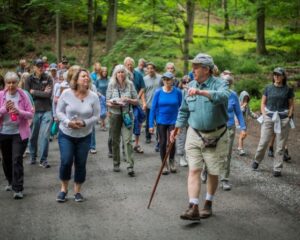Name of interviewee: Emily Leith-Ross
Date of birth/age at interview: March 18, 1901/85
Interviewer: Rita Durrant
Interview date: December 10, 1986
Interview location: Leith-Ross home at Pennswood Village
Interview length: 1 hour
Time span discussed: 1914 to 1980s
Summary: Emily gives us a full account of her husband’s (Harry “Tony” Leith-Ross’s) movements, background, education, and painting activities. Clearly a force herself, she led a very active social life in and around Solebury, New Hope, and Phillips Mill, and thus offers details about many of the artists, their wives, and social life. Especially of interest is her reporting of the Phillips’ Mill theater ‘heydays’ where she was a creator, playwright, and energized instigator of many fun moments. (Note: The interviewer often cannot be understood due to the poor recording, but Emily is fully voiced and easy to understand.
Time markers:
00:00:00 – interviewer indistinct
00:00:45 – home in Woodstock, NY; why moved to Buck’s County area
00:02:50 – Tony’s friendship with Jack Folinsbee
00:03:23 – moved to Jericho Valley in 1934; still feeling effects of the Depression
00:05:20 – Tony painting in Bucks County, how different from English country side
00:05:48 – painting Bucks County farms before they were fixed up, US farms had character
00:06:47 – Tony’s family background
00:08:10 – Tony came to USA at age 17 due to asthma; first ventures in art
00:08:56 – Tony to Denver, commercial artist; Paris, New York
00:09:40 – one daughter; schooled in Jericho Valley one-room schoolhouse; Buckingham Friends, and Holmquist School
00:11:02 – social life of family centered around Phillips’ Mill
00:11:30 – village store in New Hope
00:12:10 – new families in town; co-op formed and opened on South Main Street; some stories about the co-op (more about co-op, 21:50)
00:13:57 – Bucks County Playhouse opens
00:14:35 – co-op, Quakers managed for good of the community, overtaken by Lambertville’s Acme
00:15:54 – why artists group together, materials available, exhibitions
00:17:42 – needed inexpensive living, artists drifted away from area when it became expensive
00:18:30 – Phillips’ Mill art exhibitions: Ranulph Bye, Bill Smith, Joseph Crilly, Charles Wells
00:19:49 – indistinct but possibly discussion about Modern Art
00:21:15 – Eugene Speicher considered “modern” in 1920s
00:22:00 – topic indistinct
00:24:35 – copy of Rembrandt painting at Art Institute of Chicago, her mother studied there
00:26:05 – indistinct
00:26:52 – trains and transportation
00:28:28 – friends and social acquaintances: Daniel Garber, Jack Folinsbee, writers in Jericho Valley, Phillips’ Mill for other artists, Bill Taylor
00:29:49 – organizing the Mill art shows: Edward Redfield out of picture, William Lathrop, Clarence Carter, Ben Solowey, John Sharp, Paul Crostwaith, Faye Badura, Ben Badura, Fern Coppedge, M. Elizabeth Price, Don Hedges, Russell Jones
00:34:03 – New Hope co-op art gallery; Art Feld, Charlie Child, Jack Folinsbee, Tony Leigh-Ross, Bill Ney
00:35:44 – indistinct
00:36:55 – Garber description
00:37:12 – discussion of her medical problems, some indistinct
00:39:48 – Lathrop description; his color palette
00:40:20 – Garber was a “jolly little soul”
00:41:34 – Phillips’ Mill; social center; artists made great costumes
00:43:02 – writing musical comedies for Phillips’ Mill with Dorothy Sommer and Aldin Wicks
00:45:36 – play about Russia and the United Nations; contingent from UN to Phillips’ Mill to see
00:48:33 – other Phillips’ Mill plays
00:51:50 – current actors in the plays
00:52:30 – no longer active as writer of plays
00:52:20 – Pennswood Village and her possessions
00:53:49 – Tony’s paintings in her home
00:56:23 – indistinct, possible discussion of paintings in her home
00:58:52 – Nova Scotia story
01:00:56 – Tony not prolific painter; most paintings sold
01:03:35 – art shows at Pennswood Village
01:04:12 – Tony not keen businessman; Ranulph Bye good at both painting and business


